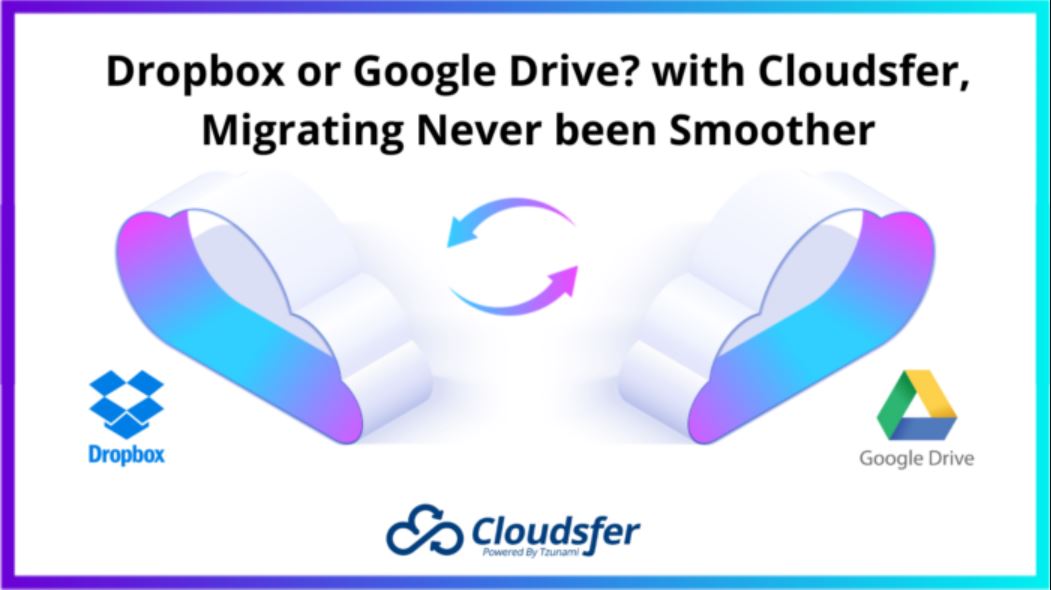Dropbox or Google Drive? With Cloudsfer, Migrating Never Been Smoother
It is a well-known fact that cloud services played a silver bullet in the way we manage our data. It provided us with worldwide access to our files from any device, allowed us to store our data in one place, and share and manage our files with associates. This set the cloud not only as our technological storage space but as our virtual hive. These days, we increasingly store more data in the cloud, knowing our documents are safe and secure and can be accessed anytime, from anywhere. Cloud services are not only used for personal use, where we as individuals keep our private photos, essential documents, and more, they are also being used by business corporations for cloud services to store their company data. This created the demand for providers whereby Google Drive and Dropbox became the front leaders in cloud technology.
Google Drive vs. Dropbox, which is more suited?
This is one common query, yet, the wrong one. The predicament is not about which platform is better but more useful for your needs, Google Drive or Dropbox. Although the comparison between these two goliaths seems fair since they were the forerunners in cloud storage services, both insinuate serving the same purpose. Their standard features include: providing backup to our files in the cloud, synchronizing files among the different devices, and allowing us to share our files with people we choose. Yet, the significant differences manifest once you dig deeper.

What differentiates Google Drive from Dropbox?
Factor One: Data Security
To answer this question, we first need to disassemble each platform into different areas and analyze them compared to each other. The first area to be examined is their security level. As we all know, one of the most indispensable factors concerning our data is its security. Whether we store our family photos in the cloud or upload classified documents, we do so with the notion our files are secured from breaches. Well, truth to be told, the two platforms use two-factor authentication and encrypt our data, both in the uploading process from our devices to the cloud storage and from the cloud storage to our device. Yet, Dropbox applies an Advanced Encryption Standard (AES) 256-bit encryption, which provides a more robust version of encryption to secure our files once they’re stored, while Google Drive solely uses 128-bit encryption.
Factor Two: Free Storage Use
In this area, Google Drive offers significantly more free storage to its users than Dropbox. While Google Drive provides 15 GB of free storage, Dropbox provides you with only 2 GB, with the option to upgrade to an extra 500 MB of storage space when referring other people to use Dropbox, with a limit of 16 GB for a Dropbox basic package, and 32 GB when it’s Dropbox plus. Still, if you’re not the “persuasive type” and are highly interested in free storage use, you will probably prefer Google Drive in this case.
Factor Three: Paid Storage Monthly/Yearly
Ultimately, only you know your requirements in a competent GB. If you find the free storage offers insufficient for your demands, Dropbox offers a monthly fee of $11.99 for up to 2 TB of storage, or $9.99 per month if you pay periodically, which concludes to $119.88 per year. However, a paid storage service with Dropbox grants you additional features, such as Dropbox Smart Sync, that grant you access to your cloud files from your desktop without the need to save them to your hard drive. Moreover, you will be awarded a feature of mobile offline folders, so you will be able to sync and manage your folders to your mobile device, even when you’re offline. On the other hand, Google Drive offers you 2 TB storage for $9.99 per month or an annual fee of $99.99, which conclusively costs less than Dropbox.
Factor Four: Sharing Files
In this case, both platforms are very similar. They both provide you with the option to share your files and folders with other people. Nevertheless, the only distinctive difference between them is the safety measure Dropbox provides its users when doing so. To secure your files, Dropbox users may insert a security password on the shared files and permit access only to those who possess it. Apart from that,
the users can temporarily set the shared password, automatically terminating its validity after a specific period.
Factor Five-The synchronization process
Although we already established that the differences between Google Drive and Dropbox lie in the minutiae yet important characteristics, their syncing process is actually quite different. The Dropbox system is much faster because they sync modifications to a file in sections, while the Google Drive system uploads the whole document, which takes time.
This also affects the speed of accessing the latest version of your file on different devices. With that said, there are some more differences worth mentioning, such as while Dropbox has approximately over 500 million users, Google Drive has about one billion. Also, Google Drive is available in 48 languages, while Dropbox has only 17.
Migrating from Google Drive to Dropbox and vice versa
Clearly, these two great platforms deliver the goods when it comes to cloud technology. Still, sometimes it’s the little features that make one platform more suitable for one’s needs, and often we discover it only after using one or another of these platforms. This is a widespread phenomenon that leads to migrating from one platform to the other. However, one of the biggest worries is that during the transfer process, we will lose some of our files along the way, and that makes us apprehensive. Well, meet Cloudsfer. This is precisely the tool that will help you migrate your data safely and securely without losing any of your files and the best part? It is simple to use.
What is Cloudsfer?
Cloudsfer is a cloud data migration tool that enables you to copy the file storage, transfer it, and backup your files securely anywhere. But it is not only for a cloud-to-cloud migration but also for on-premise-to-cloud transfer. It integrates over 20 Cloud Storage Providers reachable, including Dropbox, Google Drive, Box, OneDrive, SharePoint Online, Egnyte, and many more. Cloudsfer is not only user-friendly, but it’s secured and cost-effective, and if you still need assistance? Their support team is available around the clock 24/7.
So how do we migrate between Dropbox and Google Drive via Cloudsfer?
To migrate from Dropbox to Google Drive and vice versa via Cloudsfer, you first need to create an account and go to the Migration Dashboard. Further, the Cloudsfer for Google Drive transfer service wizard will provide you with a list of their supported source systems where you first need to choose the source of your choice, for instance, Dropbox. This will open a pop-up window that will require you to sign in to your Dropbox account and permit access to Cloudsfer to your files. Your final step will be to choose the files you wish to transfer. Now, you need to select a target system, which in this case is Google Drive, select the folder and click Create Plan, and on Start migration now. When migrating through Cloudsfer, you have the option to back up the data. In addition, you can manage your migration by filtering chosen criteria. For example, you can resolve the max file size to migrate, minimum file size to migrate, migrate files that have been modified after a specific date, migrate files that have been modified before a particular date, and more.
Cloudsfer: Why compare when you can examine?
The uniqueness of Cloudsfer is that anybody can easily migrate their data, even if they are not tech-savvy. This user-friendly tool really saves us time and effort when we choose to migrate from one platform to another, and it’s not only Google Drive and Dropbox, Cloudsfer list of sources includes Amazon S3, OneDrive, Egnyte, and more. Now, you can put aside the never-ending dilemma of which platform is better, Google Drive or Dropbox, and just easily migrate from one to another. Ultimately, the best conclusions are experienced derived, and Cloudsfer is the perfect solution to examine which cloud technology is the best suited for you.




